
The Ruger Predator is supplied with matching matte stainless 1″ medium height rings, however, with a Bushnell Elite 6500 4.5-30 x 50mm with a 30mm tube installation planned, a set of 30mm Ruger rings were substituted. Ruger does offer a swap out program where unused rings packaged with a newly purchased rifle may be swapped for a different height, material type or tube size. Specifics are covered on the Ruger web site in their FAQ section.
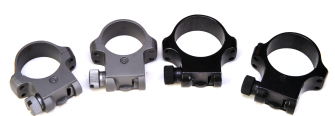 Personally, I’m always conflicted over ring material. Should they match the rifle or scope? I finally settled on a hierarchy of scope ring decision making that works for me. First, do the rings fit on the gun? Second, do the same rings fit the scope? Third, see first and second. If I’m really being picky about rifle aesthetics, rings should match the scope and I never buy silver scopes. They are… unnatural. Probably of greater consequence… the Ruger receiver is stepped and an aft ring in higher than the front. In this case, the aft ring is 1.156″, the front ring 1.031″, which parked the large scope objective close to the barrel. The scalloped bolt handle provided plenty of clearance for the scope’s oversize eyepiece.
Personally, I’m always conflicted over ring material. Should they match the rifle or scope? I finally settled on a hierarchy of scope ring decision making that works for me. First, do the rings fit on the gun? Second, do the same rings fit the scope? Third, see first and second. If I’m really being picky about rifle aesthetics, rings should match the scope and I never buy silver scopes. They are… unnatural. Probably of greater consequence… the Ruger receiver is stepped and an aft ring in higher than the front. In this case, the aft ring is 1.156″, the front ring 1.031″, which parked the large scope objective close to the barrel. The scalloped bolt handle provided plenty of clearance for the scope’s oversize eyepiece.The .22-250 Remington… not actual size
In an effort to achieve mutual understanding through comparative association L-R: .223 Remington, the Predator’s .22-250 Remington and the .220 Swift. Both the .22 Savage High Power and .22 Newton were withheld from the comparison as only six living people remember what they are. Yes, I am one of them.
On a note of blasphemy, the .22-250 Remington isn’t a sophisticated wildcat. Before factory brass was available, .22-250 brass was made by passing a .250 Savage case through a single neck reducing forming/sizer die. However, the results of this simple modification to a mundane factory cartridge is quite spectacular in terms of performance and efficiency. Therein lies the genius of the .22-250 Remington.
The .22-250 Remington wasn’t exactly an overnight success. Its wildcat roots date back to 1915, with more formal development taking place in the 1930s when it was trademarked by J.E. Gebby as the “.22 Varminter”. The round was finally homologated by Remington in 1965. No, I am not a historian, I’m just parroting the preface cartridge comments that appear in most reloading manuals.
My guess is that neither controversy of design nor difficulty of case fabrication was the cause for the .22-250 Remington’s 50 year incubation period. I think it was more a case of patient handloaders waiting for the Great Bullet Renaissance of the 1960s when bullet construction, tapered jacket design, bonded cores, enhanced manufacturing methods and control finally yielded 0.224″ bullets that could handle this cartridge’s very high velocity. Additionally, enhancements to barrel steel and barrel making in the 60’s produced barrels that wouldn’t be shot out within a few hundred rounds.
With a case capacity of 43.5 grains, 2 less than the .250 Savage parent case, the .22-250 Remington holds 3.5 grains less than the swift and a whopping 15.5 grains more than the .223 Remington. TheReal Guns Barrel Burner Index Calculator gives the .22-250 Remington a 12.6 rating compared to 13.1 for the Swift and a leaf blower like 6.9 for the .223 Remington.
Bullet points… off topic wandering for a moment
The Ruger Hawkeye Predator has the same twist rate as my .220 Swift, 1:14, which theoretically narrows bullet selection to a weight range of 45 grains to just under 60 grains which, essentially negates the use of those spiffy 60+ grain 0.224″ bullets. Why apply a slow twist to such a barn burner of a cartridge when there is enough propellant to launch heavy weights into orbit?
When bullets rotate too slowly, they do not stabilize, they exhibit angular deviation about the bullet’s axis and spread out groups shot to a common intended point of impact. When bullets rotate too fast, the effects of minor variations in material density or flaws in material or design are greatly amplified and bullets becomes unstable in similar ways. Since the .22-250 Remington is intended to pop varmints at varying distances beyond 300 yards, lightweight, high velocity, flat shooting bullets with minimal time in flight are preferred, which are consistent with the relatively slow twist rate.
The real goal of twist rates is to get a bullet spinning between 200,000 and 260,000 RPM when it leaves the muzzle. Yes, the chart is as confusing as I could possibly make it, but I think it illustrates the dynamics of the situation. It is easier to get a cartridge of lesser velocity potential to accommodate both ends of the bullet weight spectrum by striving for moderate performance at both ends of the bullet weight spectrum. Hot rod cartridges are like hot rod cars, they are great for their intended purpose, but not so good for all purposes. High performance has its tradeoffs.

| Cartridge |
Bullet |
Bullet
Weight |
Suggested Twist |
Gun Twist
Rate |
Muzzle
Velocity |
Bullet
RPM |
| Mfg. |
Greenhill |
| .223 Remington |
Hornady BTHP |
68 grains |
10 |
9 |
10
|
3,000 |
216,000 |
| .22-250 Remington |
Hornady BTHP |
68 grains |
10 |
9 |
14
|
3,300 |
169,714 |
| .223 Remington |
Barnes M/LE |
62 grain |
9 |
9 |
9 |
3,000 |
240,000 |
| .22-250 Remington |
Barnes M/LE |
62 grain |
9 |
9 |
14
|
3,500 |
180,000 |
There is another side to this issue that pertains to COL and the length of heavy for bore bullets. The length of a .22-250 Remington case is 1.912″. The .22-250 Remington’s COL is 2.350″. The design maximum bullet protrusion for the .22-250 Remington is 0.438″. Assuming a minimum bullet shank to case engagement of 0.200″, any bullet longer than 0.638″ will protrude further into the .22-250 Remington case, causing a substantial reduction in case capacity. Seating very long bullets like the 90 grain Berger VLD reduces the .22-250 Remington’s capacity by 8 grains and parks the origins of a bullet’s ogive inside the case neck.
The Ruger M77 Hawkeye Predator is ideally configured for the .22-250 Remington and its intended purpose. Building a heavy for bore bullet .22-250 Remington would entail rebarreling to address the need for a much tighter twist and an action that could handle a COL on the order of 2.650″. With a magazine well potential of 2.800″ and a bolt stroke of 4″, the Ruger M77 Hawkeye Predator action would be a good candidate for a custom .22-250 Remington chambered rifle with heavy bullet capability. Again, a very heavy for bore bullet gun would suggest a shooter’s commitment to a specialized application and acceptance of mortar like trajectory directed toward distant and fixed location targets. We resume our normal programming.
Handloads… The graduating class of ’10
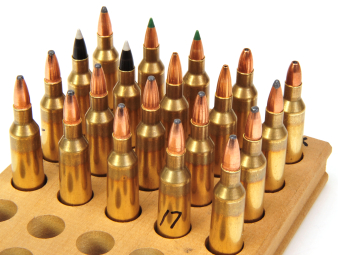 The .22-250 Remington would have to be classified as an easy cartridge to handload. Loaded with Hornady dies plugged into a Redding Turret press, the rounds popped off the press like jelly beans…. except not edible… primed and with powder inside. OK, bad analogy. Let’s just say there are no special considerations when handloading the .22-250 Remington.
The .22-250 Remington would have to be classified as an easy cartridge to handload. Loaded with Hornady dies plugged into a Redding Turret press, the rounds popped off the press like jelly beans…. except not edible… primed and with powder inside. OK, bad analogy. Let’s just say there are no special considerations when handloading the .22-250 Remington.Beginning, ironically, with new Winchester brass, cases were sized, trimmed, primed and charged. Charges were full case, but virtually none were really compressed. Neat.
I liked the look of Alliant powder when scratch prepping for handloads but, for some reason, Re15 and Re17 just didn’t churn up anticipated velocity, falling as much as 10% below predicted velocity. Hodgdon powders, including the IMR product line, seemed to live up to expectations. This is certainly not a condemnation of Alliant’s products as this phenomena has been brand reversed on other projects. Could I have pushed the Alliant loads a bit further? Maybe, but primer appearance and comparisons to mainstream reloading manuals suggest not. No percentage is running over the edge when there are well behaved alternatives.
| .22-250 Ruger M77 Hawkeye Predator Load Data |
| Bullet |
Weight
Grains |
Bullet
Length” |
COL” |
Powder
Type |
Charge
Grains |
Forecasted
Muzzle
Velocity
FPS |
Actual
Muzzle
Velocity
FPS |
Muzzle
Energy
Ft/Lbs |
100 Yd
5 Shots
Group” |
| Remington HP |
45 |
0.515 |
2.230 |
Re15 |
39.5 |
4094 |
3912 |
1530 |
0.80 |
| Remington HP |
45 |
0.515 |
2.230 |
IMR3031 |
37.0 |
4118 |
4041 |
1632 |
0.60 |
| Sierra BlitzKing |
50 |
0.782 |
2.350 |
Re15 |
38.0 |
3948 |
3691 |
1513 |
0.70 |
| Sierra BlitzKing |
50 |
0.782 |
2.350 |
IMR3031 |
35.5 |
3952 |
3839 |
1637 |
0.50 |
| Hornady SX |
50 |
0.652 |
2.350 |
Re17 |
41.0 |
3985 |
3683 |
1506 |
0.90 |
| Hornady SX |
50 |
0.652 |
2.350 |
BL-C2 |
40.0 |
3955 |
3993 |
1771 |
0.40 |
| Berger FBV |
50 |
0.720 |
2.350 |
Re17 |
40.5 |
3972 |
3726 |
1542 |
0.50 |
| Berger FBV |
50 |
0.720 |
2.350 |
IMR4895 |
38.0 |
3963 |
3907 |
1695 |
0.40 |
| CT Ballistic Tip |
50 |
0.788 |
2.350 |
Re15 |
38.0 |
3927 |
3614 |
1450 |
1.10 |
| CT Ballistic Tip |
50 |
0.788 |
2.350 |
Benchmark |
35.5 |
3858 |
3815 |
1616 |
0.90 |
| Remington PSP |
55 |
0.690 |
2.350 |
Re17 |
40.0 |
3846 |
3579 |
1565 |
0.65 |
| Remington PSP |
55 |
0.690 |
2.350 |
BL-C2 |
*38.0 |
3645 |
3631 |
1611 |
0.30 |
| Remington PSP |
55 |
0.690 |
2.350 |
BL-C2 |
39.0 |
3811 |
3829 |
1791 |
0.48 |
|
*Most Accurate | Max COL = 2.350″ | Primers = CCI 200 | Maximum, not starting loads
|

For some reason, I’ve developed the notion that .22-250 Remington rifles are not inherently accurate. This was clearly not the case with the Ruger where 5 shot groups like the 0.480″ group pictured right were not the exception. Additionally, the Predator didn’t really heat up all that much, no toasted cheese making on this barrel, and there was no evidence of stringing or erratic point of impact shifts. Groups were bumped up to five shots rather than the typical three “Let’s quit while we’re ahead efforts.” Recoil was virtually nonexistent and muzzle blast was mild. Again, pleasant surprises.
The Ruger M77 Hawkeye Predator’s shoot… icality

The range out back of the shop is a great place to shoot. The animals are exceptionally courteous. Turkeys, squirrels and other small game, that call the range home, move off while I shoot and return almost immediately afterward. I guess they know what game is in season… or they have seen me shoot.
Leaning the Ruger Predator against a tree while I set up targets almost lead to a search and recovery mission. What appeared on the photo table as a rifle with a brightly colored laminated stock and matte finished stainless hardware, proved to be quite the chameleon in a woodland setting. Didn’t expect that. I also didn’t expect 35°F temperatures, winds gusting up the back of my jacket and 29% humidity. Still, I spent more time than intended because I was sincerely enjoying shooting the rifle.
The Predator’s stock cut and geometry make for a comfortable fit. Shooting off of a bench was a snap, even when using a balled fist in place of a rear sandbag. I hung a quality shooting sling on the Predator, it comes with sling studs, and tried some standing, sitting and prone sling assisted shooting. It felt great and the gun performed admirably.
Scope position was good at 1.5″ above bore centerline and approximately 2.25″ above the stock’s comb. The scope probably could have been slipped aft maybe another half inch or so which, for me, would have helped with parallax error control.
Accuracy was excellent to the point I found I was competing against myself and I had to crank out more ammunition on the loading bench so I could keep shooting. The target trigger was a big plus. After a bit I learned to use the two stage trigger to steady before a shot and to release the sear exactly as desired. More on this feature appears in Part I.
I came to realize this isn’t a redundant varmint rifle. I own a .220 Swift and .300 Ultra Mag in heavy barrel versions. Both very accurate and both well made, but different than the Ruger M77 Hawkeye Predator. I tend not to carry either of the heavy guns far and I tend to set them up when there are known shooting distances and topography. I think the Ruger is a gun I can hang from a sling over my shoulder and go exploring for new places to shoot even if the terrain isn’t always horizontal along the way.
Looks? This is a pretty rifle and it has that appeal right out of the box. It is not a rifle that has to… grow on you. And, if the .22-250 Remington is not right for you, the gun is also available in .204 Ruger and .223 Remington. Check one out. Nice gun.
The Ruger M77 Hawkeye Predator Part I
The Ruger M77 Hawkeye Predator Part II

 Personally, I’m always conflicted over ring material. Should they match the rifle or scope? I finally settled on a hierarchy of scope ring decision making that works for me. First, do the rings fit on the gun? Second, do the same rings fit the scope? Third, see first and second. If I’m really being picky about rifle aesthetics, rings should match the scope and I never buy silver scopes. They are… unnatural. Probably of greater consequence… the Ruger receiver is stepped and an aft ring in higher than the front. In this case, the aft ring is 1.156″, the front ring 1.031″, which parked the large scope objective close to the barrel. The scalloped bolt handle provided plenty of clearance for the scope’s oversize eyepiece.
Personally, I’m always conflicted over ring material. Should they match the rifle or scope? I finally settled on a hierarchy of scope ring decision making that works for me. First, do the rings fit on the gun? Second, do the same rings fit the scope? Third, see first and second. If I’m really being picky about rifle aesthetics, rings should match the scope and I never buy silver scopes. They are… unnatural. Probably of greater consequence… the Ruger receiver is stepped and an aft ring in higher than the front. In this case, the aft ring is 1.156″, the front ring 1.031″, which parked the large scope objective close to the barrel. The scalloped bolt handle provided plenty of clearance for the scope’s oversize eyepiece.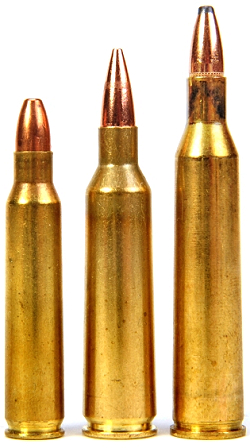
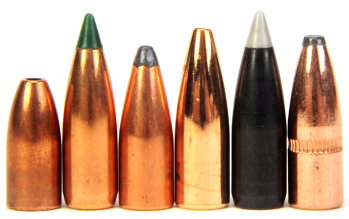
![]()
 The .22-250 Remington would have to be classified as an easy cartridge to handload. Loaded with Hornady dies plugged into a Redding Turret press, the rounds popped off the press like jelly beans…. except not edible… primed and with powder inside. OK, bad analogy. Let’s just say there are no special considerations when handloading the .22-250 Remington.
The .22-250 Remington would have to be classified as an easy cartridge to handload. Loaded with Hornady dies plugged into a Redding Turret press, the rounds popped off the press like jelly beans…. except not edible… primed and with powder inside. OK, bad analogy. Let’s just say there are no special considerations when handloading the .22-250 Remington.

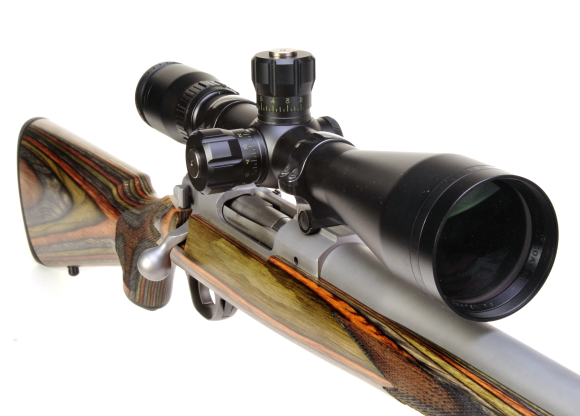

Email Notification